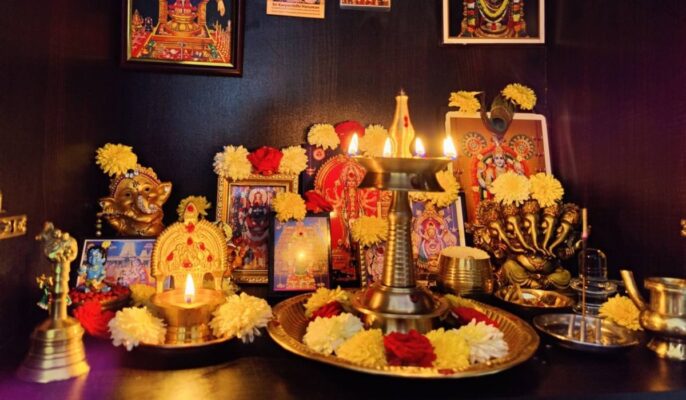The sacred practice of Pooja forms the cornerstone of spiritual life for millions of Indians. It is not merely a ritual; it’s a way of connecting with the divine, expressing gratitude, and seeking blessings. As urban living becomes more prevalent, many families are looking to bring this ancient tradition into their modern homes. To truly elevate your Pooja setup, it is essential to have the right Pooja Samagri, the materials and items used during worship. This article will guide you through the essential components that can enrich your Pooja experience and create an inviting atmosphere for spiritual connection.
Understanding Pooja Samagri and Its Importance
Pooja Samagri encompasses a variety of items necessary for conducting prayers and rituals. These items not only serve practical purposes but also carry symbolic meanings that enhance the spiritual experience. According to the scriptures, the right Pooja Samagri helps in focusing the mind, invoking the divine presence, and setting a sanctified environment. Traditionally, Pooja Samagri varies from region to region, influenced by local customs, deities worshipped, and individual preferences. However, some essentials are common across Indian households. Understanding these items’ significance will allow you to curate a Pooja setup that resonates with your spiritual beliefs.
Essential Items for Your Pooja Setup
To create a well-rounded Pooja setup, you will need several essential items. Firstly, a Pooja Thali is indispensable. This decorative plate holds all your Pooja Samagri and serves as the focal point during rituals. A beautifully designed Thali made from metals like brass or silver can enhance the aesthetic appeal of your Pooja space. Secondly, you will need incense sticks (Agarbatti) or cones to purify the air and create a serene atmosphere. The fragrance of incense is believed to attract positive energy and ward off negativity.
Flowers and Fruits: Nature’s Offerings
Flowers and fruits play a vital role in Pooja rituals, representing purity and abundance. Fresh flowers like marigolds, jasmine, and roses are commonly used to adorn the deity’s idol and the Pooja area. They symbolize devotion and are often offered to seek blessings. Fruits, especially seasonal ones, are also essential offerings. They represent the bounty of nature and serve as a token of gratitude. Furthermore, offering fruits can also be seen as a symbolic gesture of sharing the divine’s blessings with family and friends.
Puja Diyas and Candles: Illuminating the Divine Path
Light holds immense spiritual significance in Indian culture. Diyas (oil lamps) and candles are essential for any Pooja setup, representing the removal of darkness and ignorance. Lighting a diya during prayers is believed to invite divine blessings and illuminate your path. Traditional brass or clay Diyas can be used, while decorative candles add a modern touch. Ensure you have wicks and oil or ghee handy to keep the flames burning brightly throughout your rituals.
Holy Water and Kalash: The Essence of Purity
The use of holy water (Ganga Jal) and Kalash (a sacred pot) is integral to many Pooja rituals. Holy water is considered purifying and is often sprinkled around the Pooja area to cleanse the environment. A Kalash, filled with water and topped with a mango leaf and coconut, symbolizes abundance and is often placed at the altar. It serves as a vessel to invite the divine presence during prayers, making it a fundamental element of your Pooja Samagri.
Naivedya: Offering Food to the Deities
Naivedya, or food offerings, is another crucial aspect of Pooja rituals. It signifies sharing your blessings and is offered to the deities before being consumed by the family. Common offerings include sweets, fruits, and cooked dishes, which vary based on the occasion and personal preferences. Preparing Naivedya with love and devotion is believed to enhance the offering’s sanctity and invite the divine grace into your home.
Chandan and Kumkum: The Fragrance of Devotion
Chandan (sandalwood) and Kumkum (vermilion) hold special significance in Pooja rituals. Chandan is used to create a soothing fragrance and is often applied to the deity’s forehead as a mark of respect and devotion. It is also believed to have calming properties, enhancing the spiritual atmosphere. Kumkum is used for tilak, a sacred mark applied to the deity’s idol and worshippers’ foreheads, symbolizing auspiciousness and protection.
Musical Instruments: Elevating the Spiritual Vibration
Incorporating musical instruments into your Pooja setup can significantly enhance the spiritual experience. Instruments like bell (Ghanti), cymbals (Manjeera), and dholak create a rhythmic ambiance, drawing energy and focus towards the rituals. The sound of a bell, especially, is believed to attract divine attention and ward off negative energies. This auditory element enriches the Pooja experience, adding depth and vibrancy to the spiritual practice.
Creating a Dedicated Pooja Space
Having a dedicated space for your Pooja rituals is essential for fostering a spiritual atmosphere. Choose a quiet corner of your home, preferably facing east or north, and keep it clean and organized. Decorate it with sacred symbols, pictures, or idols of your chosen deities. Use natural materials and colors to create a calming ambiance. Personalizing this space with items that resonate with your spiritual beliefs will help you connect better during Pooja, making it a sanctuary for your soul.
Conclusion: A Journey of Spiritual Connection
Elevating your Pooja setup with essential Pooja Samagri transforms the way you connect with the divine. Each item, from flowers to musical instruments, plays a crucial role in creating a sanctified space that fosters spiritual growth and connection. By thoughtfully curating your Pooja Samagri and dedicating a special space for worship, you can turn your home into a haven of peace and positivity. As you embark on this journey, remember that the essence of Pooja lies in devotion and intent; the materials you use are merely tools to enhance your spiritual practice. Embrace this sacred tradition, and let it guide you on a path of mindfulness and fulfillment.





